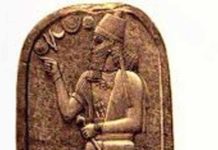The calendar of the ancient Near East was usually replete with festivals that honored the gods according to the season. One of the most famous of these festivals was the Akitu Festival of Babylon. The festival began on the first day of the month of Nisannu and lasted for 12 days. Nisannu, which coincides with April, traditionally marked the beginning of the year as it followed the vernal/March equinox.
Akitu Festivals
In Babylon the Akitu Festival was held to honor Marduk, the patron deity of the city. Throughout Mesopotamia other cities held their own Akitu festivals and in some places, such as Ur, the festival was celebrated in the spring and fall at each equinox. The archaeological evidence of the Babylonian festival goes back to the early second millennium BCE; around the time that Hammurabi and the Old Babylonian Empire set the city on its nearly 2000 year long path to greatness.
The 12 days of the Akitu Festival were each marked by special ceremonies and observances. The most basic and foundational ceremony marked the spring barley harvest wherein the king usually took on a symbolic role of presiding over the harvest. This aspect of the festival led to the formal resetting of the yearly calendar in accord with the solar cycle.
Enuma Elish
The Babylonian Creation Epic, the Enuma Elish, describes how Marduk put all of the cosmos into motion and defined the rhythm of the calendar. Accordingly Marduk is given special credit during the Akitu festival. The birth of the New Year itself was seen as ritually connected with the original creation of the cosmos by Marduk. One day of the festival was marked by a ceremonial reading of the Enuma Elish. It is possible that this epic was also symbolically reenacted in a ritual performance.
At a certain point n the festival the king would enter into the temple of Marduk known as the Esagila, and surrender his regalia of office to the high priest. The king would then undergo a reaffirmation of his right to rule as a divine representative. After being found worthy in the eyes of Marduk the king would receive his scepter, loop, mace and crown back from the high priest.
Taking The Lord By The Hand
The king then led a procession transporting the god Marduk known as “taking Bel (the Lord) by the hand.” The king would officially escort the statue of the god, presumably carried in a specially designed litter, down the processional way out of the Esagila temple and through the Ishtar Gate to the Akitu temple which lay beyond the city walls. One part of this procession led down a 200 m corridor that was flanked by the palace wall on one side and a city wall on the other. This corridor was called Aibur-shabu, which means ‘the enemy shall never pass.’ The walls of the Aibur-shabu were decorated with 120 lions, symbolic of the protective powers of the goddess Ishtar.
The king of Babylon was also responsible for escorting the god Nabû, from nearby Borsippa, to the Akitu festival. Nabû was a god of scribes who ascended in rank to a god of wisdom and joined Marduk at top of the pantheon, first as his assistant then as his son. At times when Babylon held dominion over Sumer and Akkad other gods from more distant cities would travel, in the guise of their statues, to Babylon to reside for a few ceremonial days in the Akitu temple.
During this time there was a ceremony called hašadu. This involved what has been called a sacred or ritual marriage between two gods. In this case between Marduk and his consort Sarpanitu. During the ceremony the statues of the two deities would be placed for a time on a ritual bed designed for the occasion.
The Neo-Babylonian Empire
One of the final acts of the festival was the reception and enthronement of Nabû. This god was not coincidentally the namesake of Nebuchadnezzar (c. 605 – 562 BCE) who rebuilt the processional way in its famed opulence. The name Nebuchadnezzar means ‘O Nabû, protect my offspring.’ However within a few decades of his rule the prospects of the festivals continuation fell into jeopardy.
Sometimes political turmoil and unrest prevented the gods from travelling to the Akitu temple. One such occurrence was around 960 BCE when desert tribesmen had infiltrated the urban precincts of Babylonia and forced the city to keep its gates closed. However those temporary disruptions were not as disturbing to the Babylonians as the well known absence of the festival which occurred during the middle of the sixth century ca. 553-543 BCE. During this time king Nabonidus (ca. 556-539 BCE), whose name means, ‘the god Nabû has exalted’, mysteriously led his army into the deserts of Arabia for a ten year stint during which the festival could not be held.
This neglecting of the kings sacred duties by Nabonidus prepared the Babylonians to welcome the Persian conqueror Cyrus the Great as a liberator in 539 BCE. After Cyrus had secured Babylon, and Nabonidus had been taken prisoner, the Persian King had his own son Cambyses preside over the Akitu festival of 538 BCE. This highly symbolic moment marked the end of Babylon’s rule as the capital city of the region and as far as can be determined the Akitu festival was never held in the city again.
Sources
- Johnson, Sarah, (Religions of the Ancient World, Belknap Press, Cambridge, 2004)
- Roux, George, Ancient Iraq, (Penguin Books, London, 1966.)
- Saggs, H.W.F. Babylonians, (University of California Press, Berkeley, 2000)
- Black and Green, Gods, Demons and Symbols of Ancient Mesopotamia,(University of Texas Press, Austin, 2003.)







